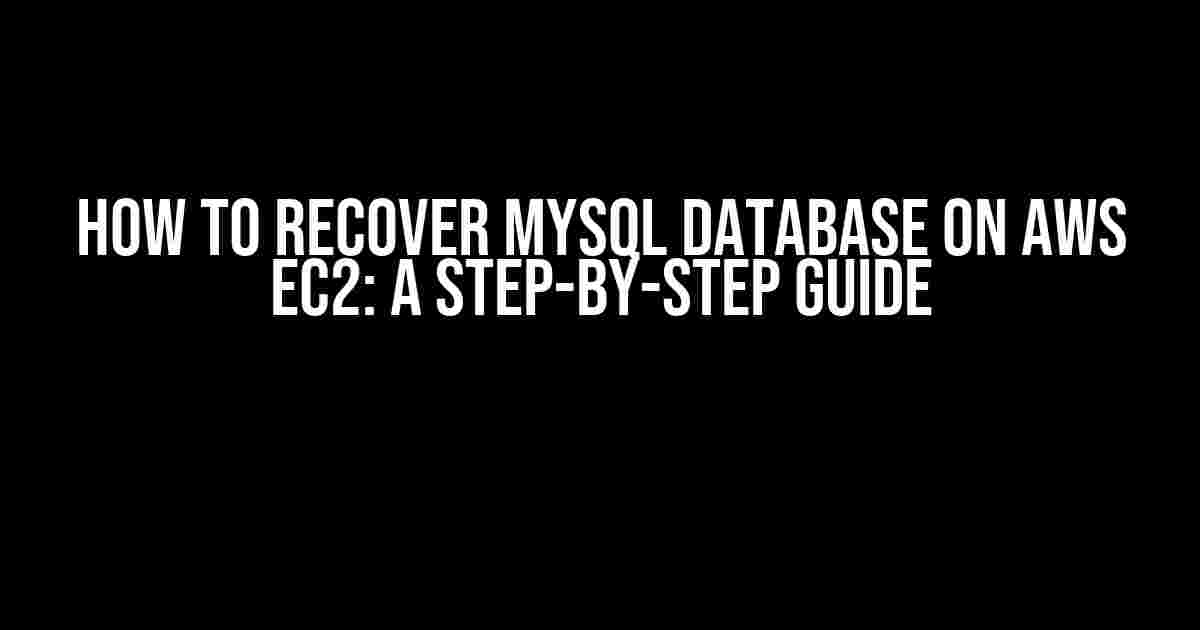Oh no! Your MySQL database on AWS EC2 has crashed, and you’re left staring at a blank screen, wondering how to recover your precious data. Don’t worry, we’ve all been there! In this article, we’ll take you through a comprehensive, step-by-step guide on how to recover your MySQL database on AWS EC2. Buckle up, and let’s get started!
Before You Begin
Before we dive into the recovery process, make sure you’ve taken the following precautions:
- Stop any running MySQL processes on your EC2 instance to prevent further data corruption.
- Take a snapshot of your EC2 instance to ensure you have a backup of your data.
- Familiarize yourself with the AWS EC2 and MySQL command-line tools.
Step 1: Identify the Problem
To recover your MySQL database, you need to identify the root cause of the issue. Check the following:
- Error logs: Check the MySQL error logs for any indications of what went wrong. You can access the error logs in the MySQL data directory, typically located at `/var/lib/mysql/`.
- System logs: Check the system logs for any error messages related to MySQL.
- File system issues: Run the `df -h` command to check for disk space issues.
Step 2: Start MySQL in Safe Mode
To prevent further data corruption, start MySQL in safe mode:
sudo mysqld_safe --skip-grant-tables --skip-networkingThis will start MySQL without networking and grant tables, allowing you to access the database without risk of further damage.
Step 3: Fix Corruption Issues
Run the following commands to check and repair any corrupted tables:
mysqlcheck -u root -p --all-databases --fast --auto-repairReplace `` with your MySQL root password.
If you have a specific database or table that’s corrupted, you can run the following command:
mysqlcheck -u root -p --fast --auto-repairReplace `` with the name of the corrupted database.
Step 4: Restore from Backup (If Available)
If you have a backup of your MySQL database, you can restore it using the following commands:
mysql -u root -p < backup_file.sqlReplace `` with your MySQL root password, `` with the name of the database, and `backup_file.sql` with the path to your backup file.
Step 5: Initialize MySQL
Once you've repaired or restored your database, initialize MySQL:
sudo mysqld --initializeThis will re-initialize the MySQL database and grant tables.
Step 6: Restart MySQL
Restart the MySQL service to apply the changes:
sudo service mysql restartAlternatively, you can use `sudo systemctl restart mysql` on systems that use systemd.
Step 7: Verify Database Integrity
Run the following command to verify the integrity of your database:
mysql -u root -p -e "CHECK TABLE "Replace `` with your MySQL root password and `` with the name of the table you want to verify.
Troubleshooting Common Issues
If you encounter any issues during the recovery process, refer to the following troubleshooting tips:
| Issue | Solution |
|---|---|
| Error 1049: Unknown database | Check if the database exists in the MySQL data directory. If not, restore from backup or recreate the database. |
| Error 2002: Can't connect to local MySQL server | Check if the MySQL service is running. If not, restart the service. |
| Corrupted system tables | Run `mysqlcheck` with the `-- repair` option to repair system tables. |
Conclusion
Recovering a MySQL database on AWS EC2 can be a daunting task, but with the right steps, you can restore your data and get back up and running in no time. Remember to take regular backups, monitor your database performance, and stay vigilant for potential issues. With this guide, you'll be well-equipped to tackle any MySQL recovery challenges that come your way!
Did you find this article helpful? Let us know in the comments section below!
Happy recovering!
Frequently Asked Question
Are you struggling to recover your MySQL database on AWS EC2? Don't worry, we've got you covered! Here are the top 5 questions and answers to help you recover your database in no time.
Q1: How do I recover my MySQL database from a snapshot on AWS EC2?
To recover your MySQL database from a snapshot on AWS EC2, first, create a new MySQL instance with the same configuration as the original instance. Then, restore the database from the snapshot using the AWS Management Console or the AWS CLI command `aws rds restore-db-instance-from-db-snapshot`. Finally, update the database endpoint and port in your application to point to the new instance.
Q2: What are the necessary steps to take before recovering my MySQL database on AWS EC2?
Before recovering your MySQL database, make sure to identify the root cause of the issue, stop any ongoing writes to the database, and take a snapshot of the current database instance. Additionally, ensure you have sufficient storage and IOPS available to restore the database.
Q3: Can I recover my MySQL database from a backup file on AWS EC2?
Yes, you can recover your MySQL database from a backup file on AWS EC2. First, create a new MySQL instance, then use the `mysql` command-line tool to import the backup file into the new instance. Make sure to update the database endpoint and port in your application to point to the new instance.
Q4: How do I troubleshoot common issues during MySQL database recovery on AWS EC2?
To troubleshoot common issues during MySQL database recovery, check the database error logs for any errors or warnings, verify the database instance status and configuration, and ensure the necessary dependencies and packages are installed. Additionally, check the security group settings and VPC configuration to ensure they are not blocking the recovery process.
Q5: Are there any best practices to prevent MySQL database corruption on AWS EC2?
Yes, there are several best practices to prevent MySQL database corruption on AWS EC2. These include regularly backing up your database, implementing database backups and snapshots, monitoring database performance and logs, and ensuring adequate storage and IOPS capacity. Additionally, follow security best practices, such as using secure passwords and limiting access to the database.
